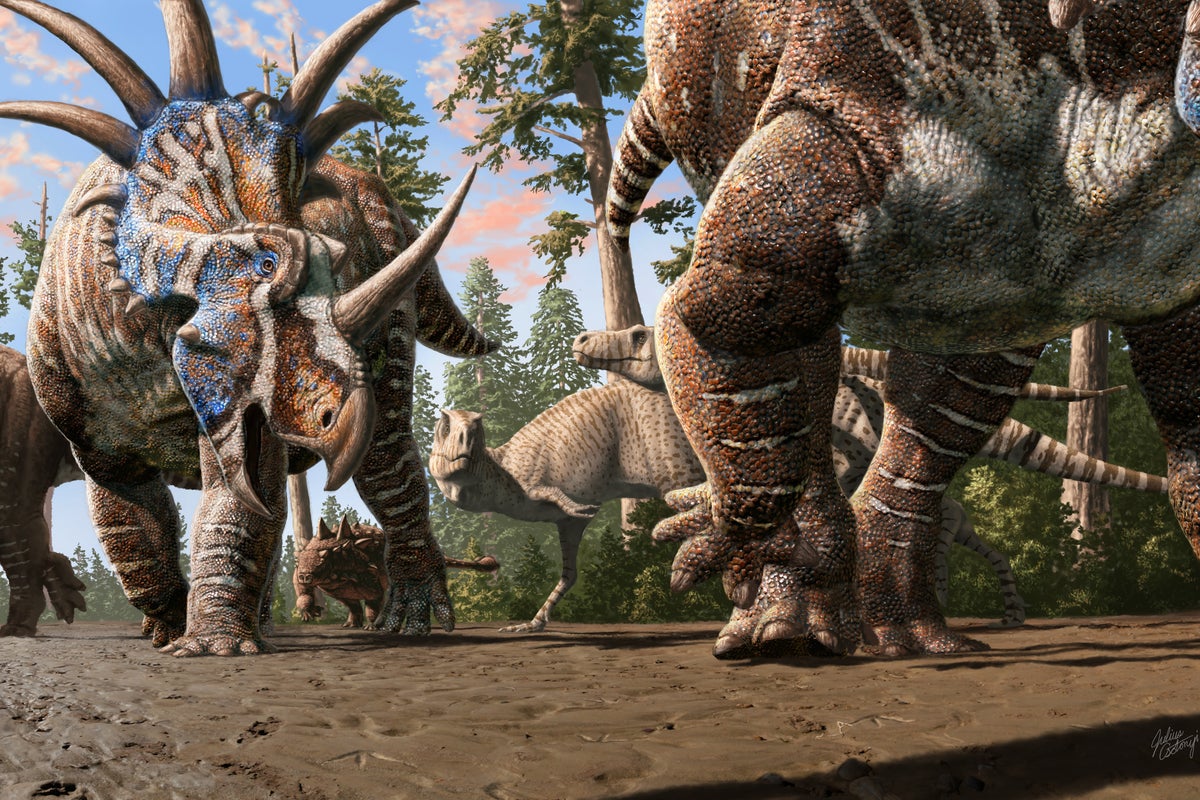Science
Fossil Footprints in Canada Reveal Dinosaurs Herding Together

Fossil footprints unearthed in Alberta, Canada, provide groundbreaking evidence that different dinosaur species herded together. This discovery, located at the Dinosaur Provincial Park, marks the first documented instance of mixed-species herding behavior among dinosaurs, akin to modern herds of wildebeest and zebra on the African plains. The findings were detailed in a recent publication in the journal PLOS One.
Researchers, including those from the University of Reading in the UK, were surprised to find fossil tracks of two tyrannosaurs walking side by side, in a formation perpendicular to a herd of mixed species. This multispecies behavior could suggest a defensive strategy against apex predators such as T. rex, according to the study authors.
The fossil site spans approximately 30 square meters and contains the tracks of at least five horned dinosaurs moving together. Notably, tracks from an armored dinosaur, likely an ankylosaurus, were also discovered within the herd. Additionally, footprints of a small meat-eating dinosaur were identified, suggesting a complex ecosystem at play.
Phil Bell, a co-author of the study from the University of New England, expressed his fascination with the discovery. “I’ve collected dinosaur bones in Dinosaur Provincial Park for nearly 20 years, but I’d never given footprints much thought,” he remarked. The conditions of the rock formation resembled mud disturbed by feet, prompting his interest.
The tyrannosaur tracks present a chilling implication, as Bell noted, “The tyrannosaur tracks give the sense that they were eyeing up the herd, which is a pretty chilling thought, but we don’t know for certain whether they crossed paths.”
Further exploration at the site has revealed additional track locations within the varied terrain of the park, which researchers are eager to investigate. Brian Pickles, another author from the University of Reading, emphasized the excitement of walking in the footsteps of dinosaurs that lived approximately 76 million years ago.
Dr. Caleb Brown, also involved in the research, highlighted the significance of Dinosaur Provincial Park, noting its status as one of the best-understood dinosaur assemblages globally. “More than a century of intense collection and study has taken place here, but it’s only now that we are getting a sense of its full potential for dinosaur trackways,” he stated.
With ongoing digs planned, researchers anticipate that further excavations will unveil more insights into the social interactions and behaviors of dinosaurs in their natural habitats. This pioneering work not only enriches our understanding of ancient ecosystems but also paints a vivid picture of the complex lives these prehistoric creatures led.
-

 Entertainment3 months ago
Entertainment3 months agoAnn Ming Reflects on ITV’s ‘I Fought the Law’ Drama
-

 Entertainment4 months ago
Entertainment4 months agoKate Garraway Sells £2 Million Home Amid Financial Struggles
-

 Health3 months ago
Health3 months agoKatie Price Faces New Health Concerns After Cancer Symptoms Resurface
-

 Entertainment3 months ago
Entertainment3 months agoCoronation Street’s Carl Webster Faces Trouble with New Affairs
-

 Entertainment3 months ago
Entertainment3 months agoWhere is Tinder Swindler Simon Leviev? Latest Updates Revealed
-

 Entertainment4 months ago
Entertainment4 months agoMarkiplier Addresses AI Controversy During Livestream Response
-

 World2 weeks ago
World2 weeks agoBailey Announces Heartbreaking Split from Rebecca After Reunion
-

 Science1 month ago
Science1 month agoBrian Cox Addresses Claims of Alien Probe in 3I/ATLAS Discovery
-

 Entertainment2 weeks ago
Entertainment2 weeks agoCoronation Street Fans React as Todd Faces Heartbreaking Choice
-

 Health4 months ago
Health4 months agoCarol Vorderman Reflects on Health Scare and Family Support
-

 Entertainment4 months ago
Entertainment4 months agoKim Cattrall Posts Cryptic Message After HBO’s Sequel Cancellation
-

 Entertainment3 months ago
Entertainment3 months agoOlivia Attwood Opens Up About Fallout with Former Best Friend





















